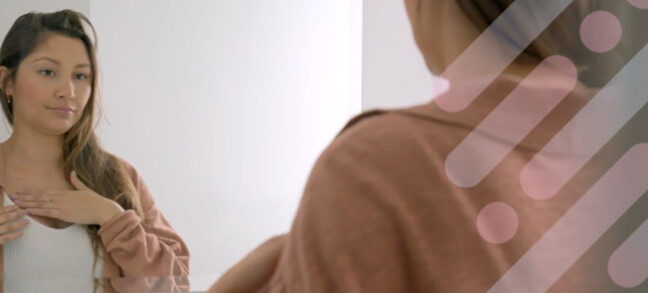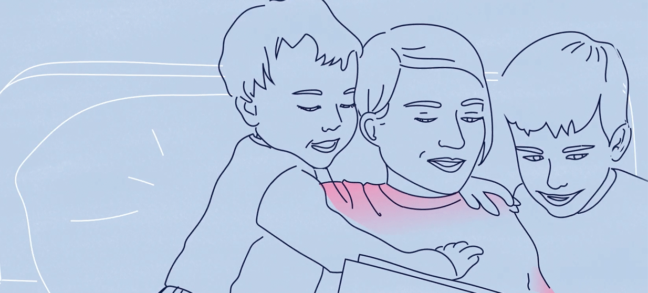From enjoying a warm breeze on your skin to feeling the hug of a loved one, sensation helps us connect to the world around us. But mastectomy cuts the nerves in your chest, leaving you partially or fully numb. Resensation has the potential to restore sensation by reconnecting nerves cut during breast reconstruction.
After surgery, your body will be hard at work recovering. It will take time for your nerves to regrow. This means you may start regaining sensation several months after surgery, with feelings continuing to develop for up to two years.1 Everyone’s experience is unique, and the level of returned sensation will vary.
sensory retraining: video guide
You may be wondering if there’s anything you can do to support your recovery.
Sensory retraining (also known as sensory re-education) is a set of simple exercises designed to encourage neuroplasticity (the brain’s ability to create new neural pathways) as your nerves regenerate and heal.
To learn how it works, watch the video guide or read our step-by-step instructions.
how can sensory retraining help me reconnect with my body?
Sensory retraining is a type of exercise commonly used to improve sensory function in many areas of the body.2-4 The practice draws on the combined expertise of sensory nerve rehabilitation therapists and physicians specializing in nerve-related traumas.
The goal is to help retrain your brain and body to connect sensory responses with sensory stimuli through consistent practice.
sensory retraining: step-by-step instructions
After your surgeon gives you the okay to start sensory retraining, you can perform the exercises twice daily, once in the morning and once at night. All you need is a mirror, a cosmetic brush and an ice cube.
Spend a minute or two on each step, taking notice of your sensory responses as you go. The whole process should only take about 10 minutes to complete.
Remember to look at yourself in the mirror as you go—it’s important to watch as you go through the motions.
practice makes progress
The more practice you get with these exercises, the quicker your brain will work to remap its responses to stimulated nerves. Consistency and repetition are key for promoting the return of sensation after surgery. You’ll also become more comfortable with how your body looks and feels post-mastectomy.
There is no set end date for sensory retraining, and each person’s journey is unique. Think of it as a road map to help you navigate your recovery.
Your doctor is available to assist if you have any questions. And remember that healing is a process, and recovery will take time!
References
- Yano K, et al. Breast reconstruction using the sensate latissimus dorsi musculocutaneous flap. Plast Reconstr Surg. 2002;109(6):1897-1903. doi:10.1097/00006534-200205000-00018
- Huisstede BM, et al. Effectiveness of surgical and postsurgical interventions for carpal tunnel syndrome-A systematic review. Arch Phys Med Rehabil. 2018;99(8):1660-1680.e21. doi:10.1016/j.apmr.2017.04.024
- Meyer R, et al. Sensory rehabilitation after trigeminal nerve injury or nerve repair. Oral Maxillofac Surg Clin North Am. 2001;13(2):265-376. doi:10.1016/S1042-3699(20)30150-3
- Chia FS, et al. Sensory retraining of the leg after stroke: systematic review and meta-analysis. Clin Rehabil. 2019;33(6):964-979. doi:10.1177/0269215519836461
This information is noncommercial, provided for educational purposes only and does not constitute medical advice or substitute for professional medical advice. Always talk with your healthcare provider before starting sensory retraining. The level of sensation restored following use of the Resensation technique may vary and cannot be guaranteed, due to unique anatomy and other considerations. Please consult your surgeon for more detailed information.
Some links will navigate you away from the Resensation website. Links outside of resensation.com are provided as a resource to the viewer, and do not constitute an endorsement or recommendation by Axogen. Axogen accepts no responsibility for or control over the content of the linked sites.
Resensation Blog

Breast self-exams: why, when and how
A breast self-exam is a useful tool for the early detection of breast cancer.
Read More
Resensation® patient uses her platform for change
With a family history of breast cancer, Bri opted to undergo a prophylactic mastectomy, followed by immediate breast reconstruction with…
Read More
a patient’s guide to the resensation® surgical technique
A breast cancer or BRCA diagnosis can make it feel like you’ve lost control over your health. Decisions need to…
Read More
why restoring sensation matters
Losing sensation after mastectomy is more than an inconvenience. Learn how it can impact you in ways big and small.
Read More